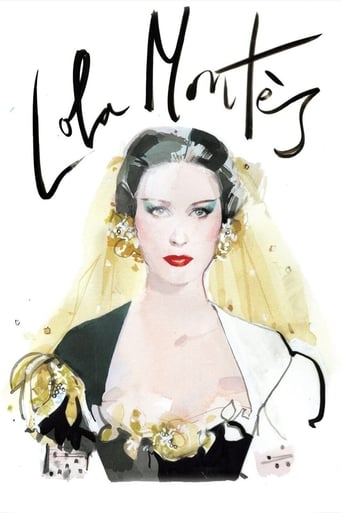gavin6942
The film tells the tragic story of Lola Montès, a great adventurer who becomes the main attraction of a circus after being the lover of various important European men.This would be the last film directed by Ophüls before his death of a heart attack in March 1957. As originally shown in France in 1955, the audience sees the events of Lola Montès' life through the use of flashbacks. Use of the technique was criticized upon its release and the movie did poorly at the box office. In response, the producers re-cut the film and shortened it in favor of a more chronological storyline, against the director's wishes.I cannot imagine this film in chronological order. What does that mean -- putting the circus at the end? What a terrible idea. Thank you, Criterion, for fixing this mess... it is so much better seeing her as the center of fascination and then having her life -- the source of the fascination -- revealed.
Equinox23
Being German I was especially impressed by the passage set in Bavaria, because at that point it became obvious to me that it was not just Lola's story Ophüls was telling but he sort of identified with her.There is this storyline when the king and Lola are still focusing on art while the self-righteous revolution is breaking out, and though I did not know at the time, I realised that it must have been the same for Ophüls when he was a director in Germany and the Nazis were gaining power. The king's longing look out of the window at all that was lost haunted me. Then there is this scene where Lola gets saved by the students, fleeing Munich in the middle of the night, just like Ophüls left Berlin at the last moment. When I was at the Parc de Bercy in Paris to watch the restored version, I sensed the great silence in the audience. Maybe like me they were thinking of all these people, who had not been so lucky.I'm so sorry that this masterpiece was not regarded as such when it was first released and even more at the fact that it was butchered subsequently. Sorry also that Ophüls himself witnessed this, but yet again grateful for the effort displayed in restoring it to its original beauty.
erictopp
It is a great shame that Max Ophuls only made one colour wide-screen movie - this one. The master of the tracking shot might have done so much more but this was his last completed movie.The scenes are mostly well-directed and beautifully photographed but the main problem with "Lola Montès" is Lola. It is impossible for the viewer to understand how this plain, charmless woman (underplayed by Martine Carol) could seduce and inspire composers and kings. Where is the beauty, the sexiness, the vivacity of Lola? I am not asking for a documentary but the real life story of Lola is so much more interesting. I know that Ophuls is commenting on the downside of celebrity - Lola wants to be a star and ends up in a circus (if Ophuls made this today, Lola would appear in a TV "reality" show or sex tape) - but without a compelling central character the spectacle falls as flat as the cardboard cutouts of Lola.
cstotlar-1
"Lola Montes" is a film about movement in every way. The famous tracking shots, so widely written about, are absolutely necessary here and in Max Ophuls' direction reached an apogee. They dominate such different story lines as "Le plaisir", "Madame De...", "Liebelei" and the rest but here the subject is motion - a life in perpetual, ceaseless motion. Actually this motive was appealing to Ophuls in general - lost earrings, the dance of the masked man and down the line -but here it uses a life as its opening premise. Actually the film is not really concerned with the title character as with the men whose lives it touches. In that capacity Martine Carol fulfills her role quite adequately. There's not much to see in Lola - she is portrayed in two dimensions throughout the film and her character was never intended to come to life. The men around her, on the other hand, are a wonderful lot with totally different responses to Lola's seductiveness and this is at the core of the film. The colors of the circus are fabulous and the season's of Lola's life depicted in some of the most sophisticated color schemes I've ever encountered. The wintry blues and whites in the palace with the snow depict the end of one man's life while the autumnal shades of her affair with Liszt were breath-taking. Someone reported that Phuls had actually painted the ground around the carriage to simulate the end of an affair. My only objection in the entire film is George Auric's overuse of his beautiful opening music at the film's beginning. It outlasted its welcome, unfortunately. This is a great film and fitting end to a remarkable career by yet another - Max Ophuls.Curtis Stotlar



